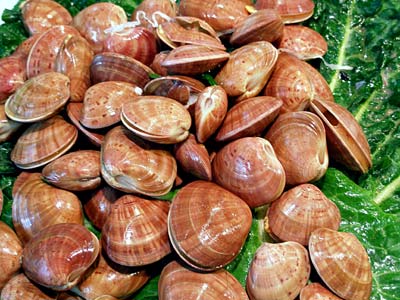A plant which grows in sand near the sea. The early shoots are eaten raw with sashimi and are used as a garnish. Later in the year it is blanched before use to remove the bitterness. It is related to water dropwort or seri and has a similar appearance except that the stems are red.
Young yellowtail. Names for this fish in Japanese vary depending on its age. Buri is the name for an older yellowtail. Compared to other kinds of fish, yellowtail is richer in protein, good fat, and vitamins A, B1, B2 and D. At its best in winter, young yellowtail appears as sashimi while mature yellowtail is grilled or simmered.

Hamaguri, or the so-called Venus clam, is found on nearly all Japan's shores. These clams are at their best from winter to spring, and are eaten as sushi, or grilled.
Sea eel or pike eel. In haute cuisine, kaiseki ryori, meals, this is served raw and so finely shredded on a central core of bone that it is difficult to tell that the flesh is actually meat and bone. We were served this at a kaiseki ryori and found it very difficult to eat. We had happily eaten the raw sea cucumber and the pond weed, the fish which had been vomited by cormorants and the raw liver of some nameless sea creature, but the shredded bone in the eel was extraordinary. Despite the sharpness of the knives and the delicacy of the slicing, those minute pieces of bone lodged in our beings, let alone our throats.